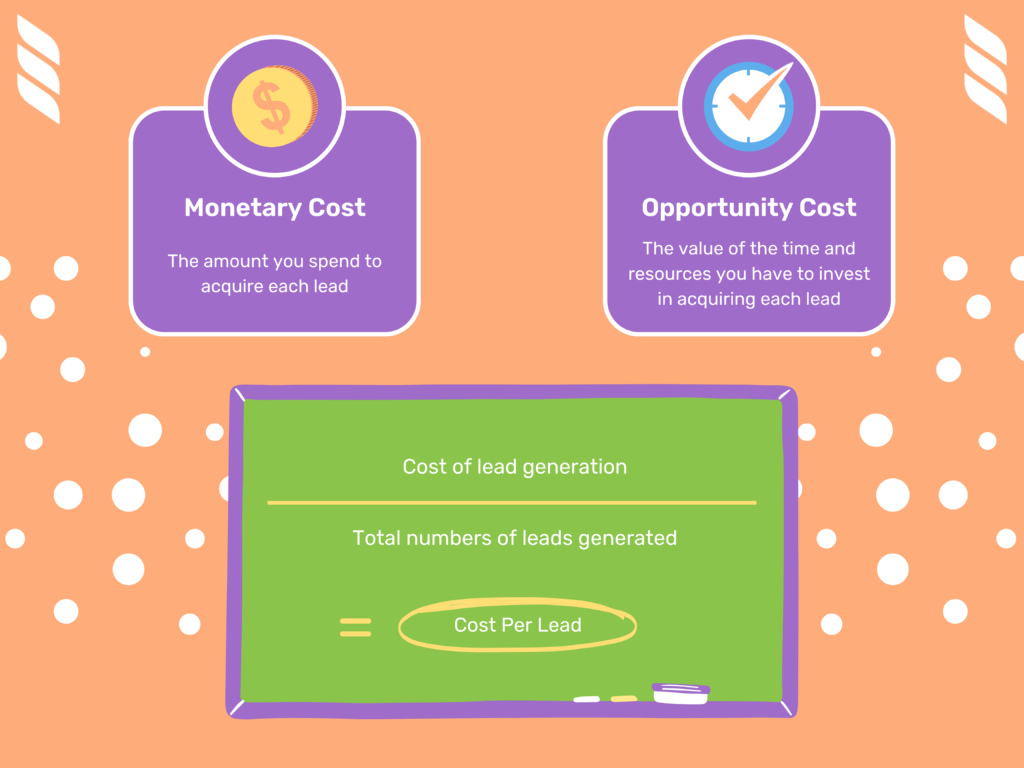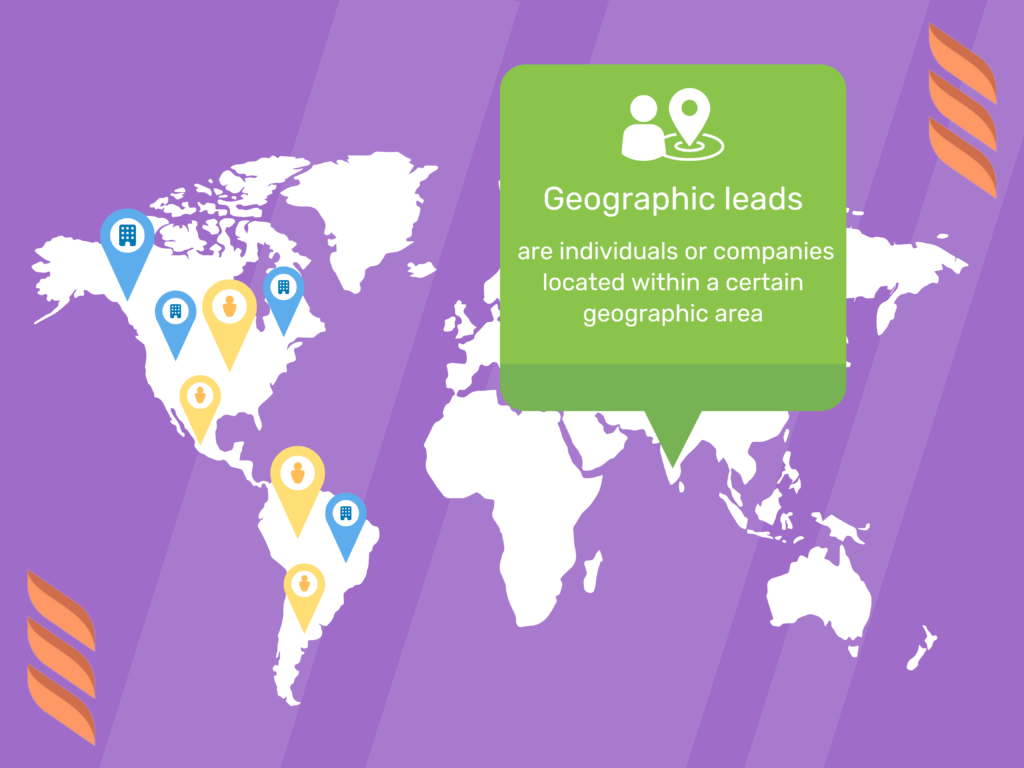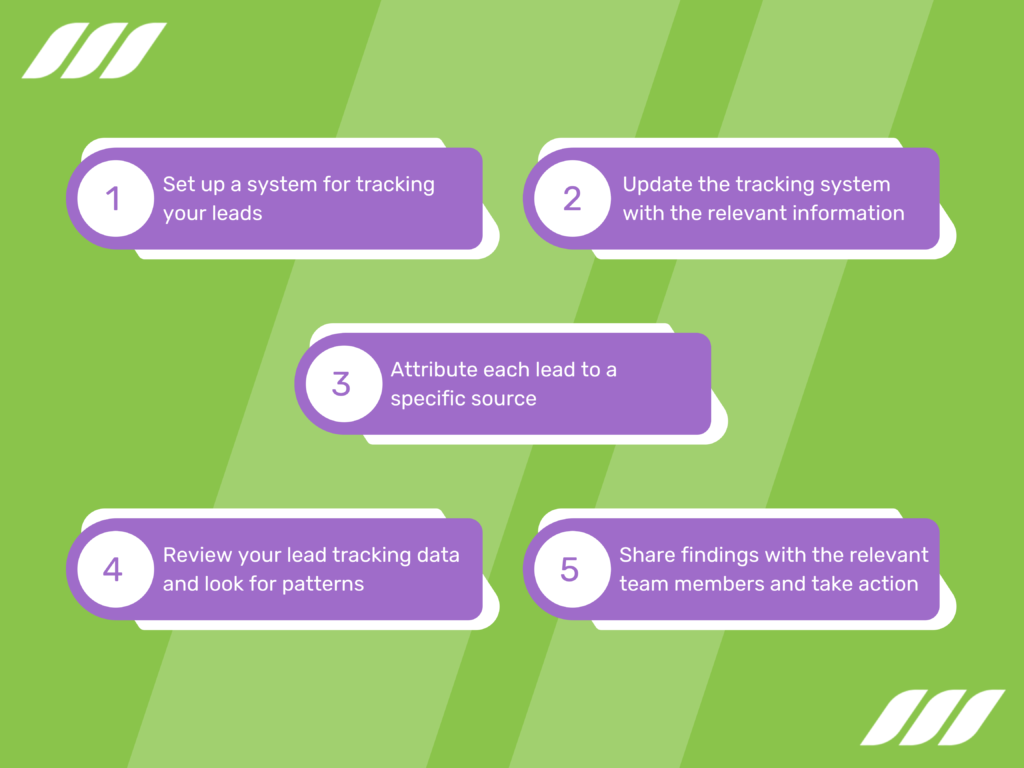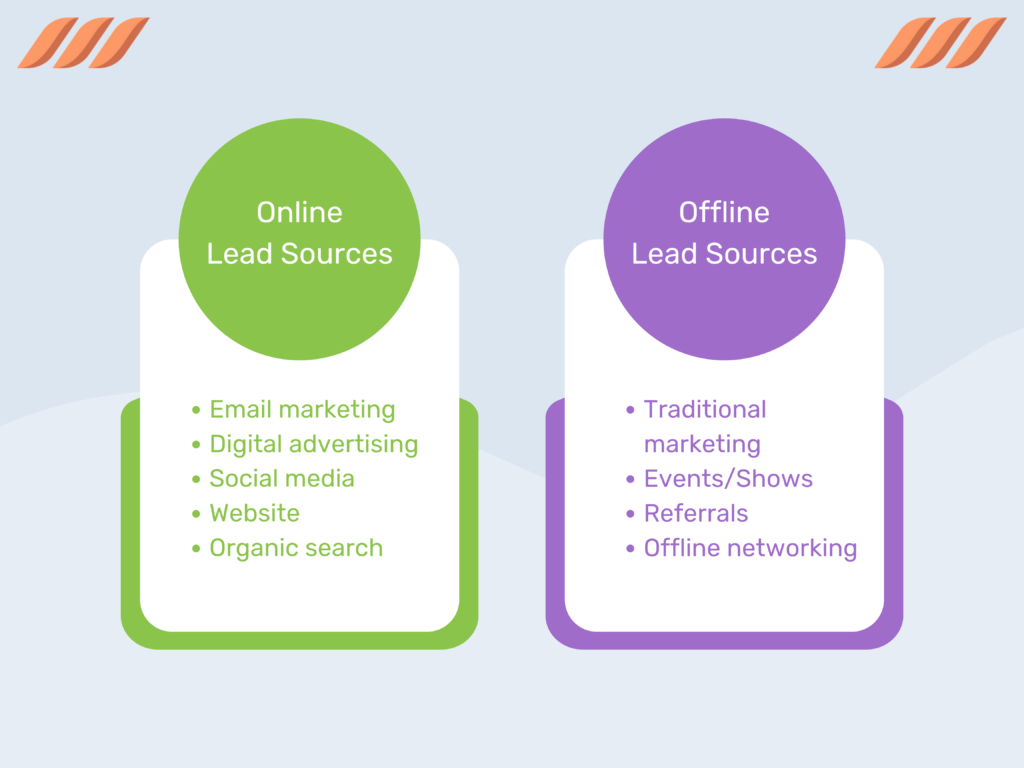|
Getting your Trinity Audio player ready...
|
A client is like a bird. They will not fly up to your window and knock on your door, asking you to provide them with your services. Where do clients come from? How do you find new ones, and how do you keep the old ones returning? It all comes down to lead sources!
Today, we’ll dive deeper into how your business might get clients and explain what you should know about lead sources. We will also explain everything you must know about the journey of leads with your business, including how to capture lead source data.
Armed with this information, you can craft a solid marketing strategy and create a stronger pipeline of potential customers. Read on to know where does a client come from (lead source).
What Is a Lead Source?
A lead source is a channel that draws a potential customer to your business by sharing information about your products or services. This lead source can be formal (set up by you) or informal (a previous customer having good experience with your business). But both serve the same purpose: introducing your brand/business to someone unaware of your brand.
Say you own a small business that sells handmade jewelry. You might generate leads by placing ads on popular fashion and beauty websites, participating in local craft fairs, or being featured in a segment about up-and-coming jewelry designers on a morning talk show.
Regardless of your methods to generate leads, always consider how you can reach more people and get them interested in your offer.
Related article: Lead Generation Marketing Trends
There are many ways someone can become a lead. For example, they may have visited your website and signed up for your newsletter, downloaded a white paper or e-book, or inquired about your product or service in any way.
The key here is that a lead is not simply someone aware of your brand. To be considered a lead, someone must have taken action indicating they are interested in learning more about your product or service.
Lead sources are essentially the channels through which you generate leads.
The common lead sources include:
- Paid advertising (such as Google Ads or Facebook Ads)
- Organic traffic (visitors who find your website through search engines like Google)
- Referrals (leads that are generated by word-of-mouth)
- Events (leads who attend trade shows or webinars hosted by your company).
Smart marketers and sales professionals capitalize on a mix of different lead sources to generate the greatest number of leads possible. Experimenting with different lead sources is the best way to determine which ones work best for your business.
For example, if you run a B2B software company, referrals will be your best bet since people in this industry do a lot of research before purchasing. And they often rely on recommendations from colleagues.
Conversely, if you own a retail store selling fashion accessories, paid advertising might be your best option. People interested in buying fashion accessories are generally more impulsive shoppers who are likely to respond to ads featuring attractive products.
The bottom line is that there is no one-size-fits-all in generating leads. Instead, the best way to figure out what works for your business is to experiment with different lead sources and track your results over time.

Why Does a Lead Source Matter?
If you’re running a business, you know how important it is to bring in leads. But what you might not realize is that the source of those leads can be just as important as the leads themselves.
A bad lead source can result in wasted time and money pursuing leads that will never convert into customers. On the other hand, a good lead source can be a goldmine for your business, providing high-quality leads that turn into sales.
Here are five factors that make a lead source crucial for your business.
Quality Over Quantity
Having a smaller number of high-quality leads is better than a larger number of low-quality leads. After all, it takes just as much effort — and sometimes even more effort — to close a deal with a low-quality lead as it does with a high-quality lead.
So, when looking at potential lead sources, ask yourself: “Will this source provide me with high-quality leads?” If the answer is no, move on and look for something better.
Cost Per Lead


A good lead source should be cost-effective, providing a high return on investment (ROI).
When considering the cost per lead, be sure to take into account both the monetary cost and the opportunity cost. The monetary cost is self-explanatory — it’s simply the amount you spend to acquire each lead.
Conversely, the opportunity cost is the value of the time and resources you have to invest in acquiring each lead.
By taking both costs into account, you’ll get a more accurate picture of whether or not a particular lead source is worth your while.
The Safety Net Factor
When choosing a lead source, you must consider what I like to call “the safety net factor.”
In other words, how easy is it to stop using a particular lead source if things go wrong?
If you’re relying on word-of-mouth referrals for your leads, it’s going to be very difficult — and potentially costly — to stop using that lead source if things go south.
However, if you’re using Google AdWords or another paid form of advertising, you can turn off the tap if things aren’t working out.
Scalability
What works well for your business today might not work so well tomorrow if your business starts growing rapidly, so undertake your lead source’s scalability. Otherwise, you risk quickly outgrowing your existing lead sources and finding yourself in a bind.
Brand Awareness/Equity Building
Lastly, don’t underestimate the importance of brand awareness and equity building when choosing a lead source. Even if a particular lead source doesn’t immediately generate sales or revenue, it can still be well worth your while if it helps build your brand and increase awareness of your product or service among potential customers.
Types Of Lead Sources
While leads are the lifeline of your business, not all leads are created equal. Some lead sources are more likely to result in conversions than others.
Here are six of the best types of lead sources for your business:
1. Word-of-Mouth Leads
Word-of-mouth leads are generated when customers tell their friends and family about your product or service. This type of lead is precious because it comes from a trusted source.
When people hear about your product or service from someone they know and trust, they’re more likely to be interested in your offer.
2. Referral Leads
Referral leads are similar to word-of-mouth but come from sources other than friends and family members. These leads can come from online reviews, social media posts, or even satisfied customers who share your information with others in their network.
Related article: How to Ask for Referrals From Your Customers
3. Cold Leads
Cold leads are individuals or companies that have shown interest in your product or service but are not yet ready to buy. These leads usually come from online sources such as website visitors who sign up for your email list or download a white paper from your website.
The key to reliable cold leads is nurturing them until they’re ready to buy. With the right marketing strategy, cold leads can eventually be converted into hot leads — the best type of lead there is.
Related article: How Fast do Marketing Leads Turn Cold
4. Hot Leads
Hot leads are interested buyers ready to purchase your product or service. They usually come from sources such as referrals, word-of-mouth recommendations, or targeted marketing campaigns. As hot leads are already interested in what you’re selling, they’re much more likely to convert into paying customers than cold leads.
5. Geographic Leads


Geographic leads are individuals or companies located within a certain geographic area. For example, if you own a brick-and-mortar store, most of your leads will likely be Geographic since people can only purchase your products or services if they’re physically close enough to visit your store.
6. Social Media Leads
Social media platforms like Facebook and LinkedIn are great places to generate leads for your business. By posting relevant and engaging content regularly, you can attract potential customers to your brand and convert them into paying customers.
These six types of lead sources should be a part of every comprehensive lead generation strategy. But, of course, they are not the only viable lead sources, as diversifying your source can ensure that you’re constantly generating high-quality leads that will help grow your business.
Related article: How Can Social Media Marketing Help Your Business
Lead Source Examples
Here are two evergreen lead source examples you can implement in your business right away:
1. LinkedIn Connection Requests


LinkedIn is a treasure trove of high-quality leads you can connect with and turn into customers. The best way to get started with LinkedIn lead generation is by sending connection requests to prospective clients. Use LinkedIn lead generation tool and get the most out of it.
When crafting your connection request, personalize the message and explain why you’re interested in connecting. This helps to create a rapport with the lead and increases the likelihood that they’ll accept your request.
Once you’ve connected with a lead on LinkedIn, take things offline by scheduling a meeting or phone call so you can further discuss how you can help them solve their problem.
Speaking of LinkedIn leads, LinkedIn Sponsored InMail is another clever lead source because it allows you to reach out to your target market directly through their inboxes. You can send a personalized message to each lead, and you can be sure that it will be seen because LinkedIn displays Sponsored InMail messages prominently in users’ inboxes. Explore LinkedIn InMail best practices to use in your outreach strategy.
LinkedIn also allows you to track how many leads responded to your message to gauge this lead source’s effectiveness.
2. Facebook Ads
Being the largest social media network in the world, Facebook provides a massive audience for you to target with your ads. And thanks to Facebook’s targeting options, you can zero in on your ideal customer and get your ad in front of them when they’re most likely to convert.
When creating your Facebook ad, use attention-grabbing imagery and copy that speaks directly to your target customer’s needs.
Plus, include a strong call-to-action that encourages leads to take the next step in your sales funnel, such as signing up for a free trial or requesting a consultation.
These tips will help you create high-converting Facebook ads that will help you generate more leads for your business.
How to Track Lead Sources?


Knowing where your leads come from is a crucial part of the lead generation process. When you don’t know which channels are most effective at generating leads, you could be wasting time and money on marketing efforts that aren’t paying off.
If you want to avoid this pitfall, here are the steps to track a lead source:
- First, set up a system for tracking your leads. This can be as simple as using a spreadsheet to track each lead’s date, source, and contact information.
Alternatively, you can use customer relationship management (CRM) software to track your leads. Many CRM platforms are available, so choose one that best meets your needs.
- Once you have a system for tracking your leads, ensure all your team members are using it consistently. This means every time a lead comes in, someone should be updating the tracking system with the relevant information.
- Another important step is to attribute each lead to a specific source to identify which channels are most effective at generating leads.
To do this, you can add a column to your tracking spreadsheet or create a custom field in your CRM software.
- The fourth step is periodically reviewing your lead tracking data and looking for patterns. This will help you identify any potential problems with your lead generation efforts and make necessary adjustments.
- Finally, don’t forget to share your findings with the relevant team members and ensure they’re taking action on your insights.
After all, what good is tracking your lead sources if you’re not going to use the data to improve your marketing efforts?
Tracking your lead sources is a vital part of any successful marketing strategy — but it doesn’t have to be complicated or time-consuming.
Why Do You Need to Track Lead Sources?
Lead tracking can help you adjust your marketing strategy and ensure you reach your target audience most effectively. There are many lead-tracking software options available, so there is no excuse for not tracking your lead sources.
Here are some reasons why you must track your lead sources:
Gauge the Success of Your Marketing Campaigns
If you are not tracking your lead sources, you cannot accurately measure your marketing campaign’s success. This information is crucial to determine which marketing channels are working and which need to be improved.
For example, if you spend $2000 on a Facebook ad campaign and it generates 100 leads, that’s a cost-per-lead of $20. If you spend the same $2000 on a Google AdWords campaign that generates 150 leads, that’s a cost-per-lead of $13.50.
As you can see, one campaign is much more effective than the other. Without tracking lead sources, you would have no way of knowing this information and making necessary changes to your marketing strategy.
Allocate Your Budget More Effectively
In addition to helping you measure the success of your marketing campaigns, tracking lead sources also helps you allocate your budget more effectively.
If you know that certain channels are not generating results, then you can redirect that money to proven effective channels. This will help you get the most bang for your buck and grow your business more efficiently.
Target Your Ideal Customer
If you track your lead sources, you can see which channels are bringing in quality leads that convert into customers. This information is valuable because it will help you focus your marketing efforts on targeting your ideal customer.
For example, if you find that most of your converted leads come from LinkedIn, then you should focus more of your efforts on LinkedIn rather than wasting time and money on other channels that aren’t as effective.
Read also: Get More Qualified Leads for Your Business


Improve Your Sales Process
If you’re not happy with your current sales process or feel like you could be selling more, we hear you.
Here are some smart tips to improve your sales process and benefit more from your lead sources:
1. Define Your Ideal Customer
The first step to improving your sales process is defining your ideal customer. This might seem like a no-brainer, but you’d be surprised how many businesses don’t take the time to do this.
By defining your ideal customer, you can save yourself a lot of time and energy down the line. You’ll know exactly who you should target with your marketing and sales efforts, and you’ll be less likely to waste time on leads that will never convert.
2. Create Buyer Personas
Once you’ve defined your ideal customer, it’s time to create buyer personas. Buyer personas are fictional characters that represent your ideal customers.
When creating buyer personas, be sure to include their demographic information, pain points, goals, and anything else that will help you better understand them. The more information you have about your buyer persona, the easier it will be to sell to them.
3. Craft Compelling Offers


If you want to improve your sales process, then you need to start with crafting compelling offers. Your offer will convince someone to buy from you, so it needs to be good enough!
When crafting an offer, make sure it’s something that your ideal customer would want or need. It should also be unique to your business and that nobody else offers.
Lastly, make sure your offer is clearly stated and easy to understand; if it’s too complicated, your potential customers will move on without giving it a second thought.
4. Write Great Copy
Once you have a compelling offer, it’s time to write great copy. Your copy will convince someone to take action on your offer, so it must be persuasive and informative.
Always keep your ideal customer in mind when writing copy for your website or sales materials. Write in a way that speaks directly to them and their needs.
And remember: less is more! Don’t try to cram too much information into each piece of copy; give your potential customers enough information so they know what they need to know and nothing more.
5. Test and Measure
Finally, once you have all the above in place, it’s time for the most important step: testing and measuring. You need to test different aspects of your sales process to see what’s working and what’s not. Try different channels and methods to see how each change affects your results.
Once you find something that works well, stick with it! And don’t forget to keep testing; even if something works well now, that doesn’t mean it will always work well in the future. The only way to know for sure is by constantly testing and measuring to stay ahead of the curve.
The Benefits of Lead Source Reporting
If you’re like most businesses, you want to know where your leads are coming from. After all, that information can be extremely valuable regarding marketing and sales strategy.
Fortunately, there’s a way to get exactly that information: lead source reporting.
If you’re unsure how does lead source reporting help your business, here are some benefits you must understand:
Measure ROI for Each Marketing Channel
In addition to helping you allocate your marketing budget more effectively, lead source reporting also enables you to measure the ROI for each marketing channel. This is important because it lets you see which channels are generating revenue for your business and which are simply costing you money.
Armed with this information, you can make more informed decisions about where to allocate your marketing spend.
Identify Your Most Profitable Customers
Another benefit of lead source reporting is that it helps you identify your most profitable customers. This is valuable information because it lets you focus on acquiring more customers like them.
By understanding which lead sources are generating the most high-value customers, you can invest more in those channels and less in others.
Fine-Tune Your Sales Process
Lead source reporting also allows you to fine-tune your sales process. When you know which channels generate the most qualified leads, you can ensure that your sales team is focusing their efforts on those channels. This will help them close more deals and increase your overall revenue.
Related article: Lead Qualification With Dripify
Get Insights Into Your Customer Journey
In addition to giving you insights into your customer journey, lead source reporting also provides valuable data that can be used to improve your customer journey map. By knowing which channels generate the most leads and where those leads drop off, you can identify pain points in your customer journey and work to resolve them.
Improve Your Lead Nurturing Processes
Understanding which channels generate the most sales-ready leads will help ensure that your lead-nurturing campaigns focus on those channels. This will help increase the number of leads that eventually convert into customers.



Lead Source Best Practices
A lead source is simply the origin of where your leads were generated – online through a web form, offline through print ads, or even through personal referrals.
Follow these best practices to ensure your lead source delivers what you expect:
1. Understand Your Customer’s Journey
Understanding each stage of the buyer’s journey is crucial to creating targeted content that speaks to their specific needs at that time. For example, if a person is in the awareness stage, they’d prefer general information about your product or service.
In contrast, a customer in the decision stage might be ready to receive a proposal or pricing information.
2. Create a Diverse Mix of Lead Sources


Don’t rely on just one lead source! Creating a diverse mix of lead sources will help you reach a wider audience and generate more qualified leads.
For example, suppose you only focus on generating leads online through your website. In that case, you’re missing out on potential leads who might prefer offline methods such as print ads or personal referrals.
By using a combination of both online and offline methods, you can cast a wider net and increase your chances of generating new leads.
3. Test, Test, Test!
Never stop testing your lead sources! Just because one lead generation method worked well in the past doesn’t mean it will continue to work well in the future.
As consumer preferences change and new technological advances are made, it’s important to continuously test your lead sources to see what’s working and what isn’t. Constantly testing and experimenting will help you be able to generate the most qualified leads possible.
Conclusion
In conclusion, lead sources are any channel or method that brings potential customers to your business. The most common lead sources are advertising, referrals, organic search traffic, and word-of-mouth marketing.
However, there are many other potential sources of leads, including trade shows, networking events, and online directories. The key is to identify the best channels for your business and focus your marketing efforts accordingly.
By doing so, you know better where does a client come from (lead source) and market accordingly to ensure that your business is attracting high-quality leads.

![How to Write a Price Increase Letter [Tips, Examples, and Free Template]](https://dripify.io/wp-content/uploads/2021/12/27.png)
![How to Write an Effective Collaboration Email [+Templates]](https://dripify.io/wp-content/uploads/2023/05/13.png)



